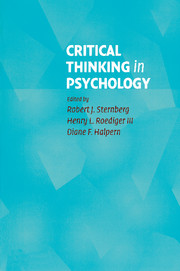Book contents
- Frontmatter
- Contents
- List of Illustrations and Tables
- List of Contributors
- Preface
- 1 The Nature and Nurture of Critical Thinking
- 2 Evaluating Experimental Research
- 3 Critical Thinking in Quasi-Experimentation
- 4 Evaluating Surveys and Questionnaires
- 5 Critical Thinking in Designing and Analyzing Research
- 6 The Case Study Perspective on Psychological Research
- 7 Informal Logical Fallacies
- 8 Designing Studies to Avoid Confounds
- 9 Evaluating Theories
- 10 Not All Experiments Are Created Equal
- 11 Making Claims in Papers and Talks
- 12 Critical Thinking in Clinical Inference
- 13 Evaluating Parapsychological Claims
- 14 Why Would Anyone Do or Believe Such a Thing?
- 15 The Belief Machine
- 16 Critical Thinking and Ethics in Psychology
- 17 Critical Thinking in Psychology
- Author Index
- Subject Index
- References
7 - Informal Logical Fallacies
Published online by Cambridge University Press: 05 June 2012
- Frontmatter
- Contents
- List of Illustrations and Tables
- List of Contributors
- Preface
- 1 The Nature and Nurture of Critical Thinking
- 2 Evaluating Experimental Research
- 3 Critical Thinking in Quasi-Experimentation
- 4 Evaluating Surveys and Questionnaires
- 5 Critical Thinking in Designing and Analyzing Research
- 6 The Case Study Perspective on Psychological Research
- 7 Informal Logical Fallacies
- 8 Designing Studies to Avoid Confounds
- 9 Evaluating Theories
- 10 Not All Experiments Are Created Equal
- 11 Making Claims in Papers and Talks
- 12 Critical Thinking in Clinical Inference
- 13 Evaluating Parapsychological Claims
- 14 Why Would Anyone Do or Believe Such a Thing?
- 15 The Belief Machine
- 16 Critical Thinking and Ethics in Psychology
- 17 Critical Thinking in Psychology
- Author Index
- Subject Index
- References
Summary
Premise 1: All good chapters begin with a pithy quote.
Premise 2: We do not begin with a pithy quote.
Conclusion: This is not a good chapter.
Is this a valid conclusion? According to formal logic, it is. Formally, an argument is valid if the conclusion follows from the premises (whether or not the premises are true) and is invalid if it does not. Thus, formal logic is only concerned with the rules for drawing conclusions from a given set of premises (Baron, 1994). It does not specify a standard for evaluating the premises themselves (except, of course, to the extent that the premises were derived as conclusions from other premises).
This chapter focuses on informal logic. Unlike formal logic, informal logic seeks standards for the generation and evaluation of premises. Thus, if Premise 1 is not supported by sufficient evidence, then, according to informal logic, the conclusion about the chapter is not valid. So don't despair: This chapter may have more promise than our opening syllogism would compel you to conclude.
A second difference between formal logic and informal logic is that formal logic deals with certainty, and therefore does not offer a way to weigh the reasonableness of multiple valid or invalid conclusions (Baron, 1994). For instance, if the first premise were, “Some good chapters begin with pithy quotes,” the conclusion would be invalid.
- Type
- Chapter
- Information
- Critical Thinking in Psychology , pp. 110 - 130Publisher: Cambridge University PressPrint publication year: 2006
References
- 6
- Cited by



